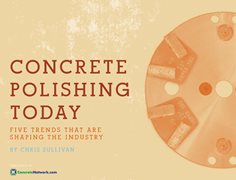- Concrete Polishing Equipment
- Get the Look - Polished Concrete Pictures
- How to Polish Concrete: Learn the basics and get a step-by-step overview
- Polished Concrete Preparation: How to clean, repair, and evaluate before polishing
- Concrete Polishing vs. Resurfacing
- Reviews of Concrete Polishing Equipment How to clean, repair, and evaluate the condition of concrete floors before polishing
- Tips on Using Polishing and Grinding Equipment
- Tips for Choosing Edge Grinders
- Selecting Dust-Collection Equipment
- Diamond Tooling: Tips for choosing the right type of diamond tooling and equipment
- Concrete Densifiers: An introduction to chemical hardeners and how they work to improve polished concrete
- 2023 Polishing Techniques: An online interview series featuring Bob Harris
Trends in Densifiers and Stain Guards for Polished Concrete
On-the-job performance and cost are the biggest factors to consider when selecting the best densification system to useThis is an excerpt from the new e-book “Concrete Polishing Today,” part of a series of reports from ConcreteNetwork.com on trends and insights about decorative concrete applications.
Concrete Polishing Today

Discover five developing trends in concrete polishing from ConcreteNetwork.com’s new e-book. You’ll also get insights and guidance from veteran polishers that will help you stay profitable in today’s market.
Download Concrete Polishing Today (PDF)
Chemical densification is arguably the most critical step in achieving long-term durability and shine on a polished concrete floor. The process involves applying a reactive metallic silicate to the concrete to increase the amount of calcium silicate hydrate in the concrete surface, which is what gives concrete its strength and durability. It also allows for the development of shine and luster through the mechanical polishing process.
The two most commonly used densifying chemicals today are sodium and lithium. Sodium has been around the longest and is considered the cost-effective workhorse of penetrating densifying sealers. Lithium is a more recent product, but has garnered a large following with claims of deeper penetration due to a smaller particle size, resulting in a more durable polished surface. On-the-job performance and cost are the biggest factors contractors consider when selecting what densification system to use, with lithium-based systems typically priced higher then sodium-based systems.
When to apply and how much to use?In regard to performance, there is still debate as to which system works better. Some contractors have a preference based on personal experience while others do not take sides and feel that is less about the system and more about when and how much chemical is used. According to Brad Walker, owner of Lone Star Decorative Concrete, Watauga, Texas, the key to success is to densify as much as possible. “Densifying is less about the product, but rather how much is used. The more you densify the better your floor,” he says. Walker is a big proponent of reading the floor to understand what chemicals to use and when to apply them. He prescribes to the process of flooding the floor initially with a lower-cost sodium-based densifier, then switching to a higher-cost lithium densifier, which allows him to use less material during the higher-grit polishing steps. Talbot is another who emphasizes quantity over chemistry. “It is more important to use enough. If you’re not, you’re not hardening the floor,” he says.
Guards for polished concrete are also a source of debate. “Theoretically, you are now adding something topically to the polished floor,” which is often sold as a floor free of any sealers or coatings, says Bob Harris, owner of The Decorative Concrete Institute, Temple, Ga. While the debate rages on, the use of guards has increased to where most polished floors are getting some type of final stain guard or sealer to help protect against certain stains and increase the shine of the floor.
Polished concrete stain guards are typically low-solids acrylic, polyurethane or epoxy systems, or blends of resins, designed to form a very thin micro-film on the surface of polished concrete. This thin film protects against stains that can etch or change the profile of the surface. Guards are often used when the polished floor is colored with a dye or stain. “We recommend guards for use on colored floors as they help pull more color and increase brightness,” says Vernon Talbot, managing director of Retro Plate Inc., Provo, Utah.
One of the downsides of using guards is overapplication. “The problem I see many contractors make is either overapplying or using these products to obtain a false shine or cover blemishes, such as scratches,” says Harris. In certain cases, he will even take gloss readings before and after applying guard to ensure they are getting the proper shine from the polishing process and not just the guard.
Maintenance is still importantAccording to Mose and Abner Peachey of Rosebud Concrete, Myerstown, Penn., guards will provide some level of protection from wear and tear, but will not block certain stains. “We don’t sell polished concrete as a stain-proof floor,” they say. Currently there is a perception that polished concrete is a zero-maintenance floor, and that is not the case. That’s why Rosebud spends a fair amount of time educating their clients on what to expect. “Have a good maintenance plan, and present it to your customer,” says Mose.
Related informationConcrete Densifiers
Maintaining High-Traffic Polished Concrete Floors
Return to Concrete Polishing Today
 Polishing Diamonds
Options for hard, medium, and soft concrete.
Polishing Diamonds
Options for hard, medium, and soft concrete.
 CPS G-170 Electric
17" Floor Grinder 230 volt ($7,600)
CPS G-170 Electric
17" Floor Grinder 230 volt ($7,600)
 Propane Concrete Polisher
Concrete Polishing HQ
Propane Concrete Polisher
Concrete Polishing HQ
 Scanmaskin Diamond Tools
A wide variety of different sizes and hardness
Scanmaskin Diamond Tools
A wide variety of different sizes and hardness
 Lythic Densifier XL
1 Gallon & 5 Gallon sizes
Lythic Densifier XL
1 Gallon & 5 Gallon sizes




